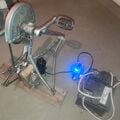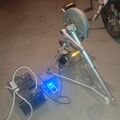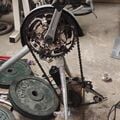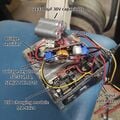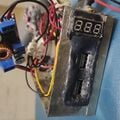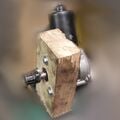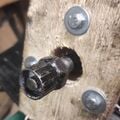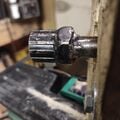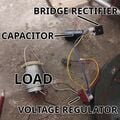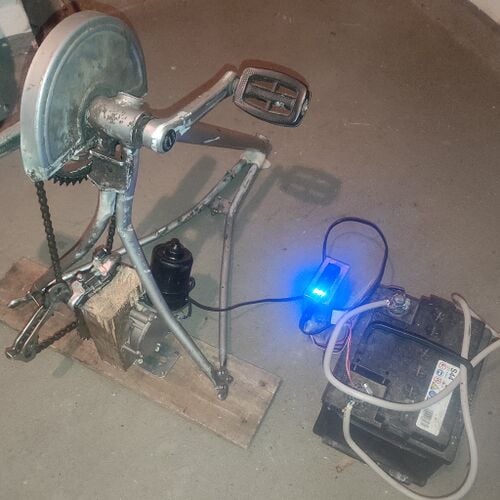
This pedal powered generator is based on a windshield wiper motor, a cheap voltage regulator from Aliexpress, a scrap bicycle and other scrap parts.
Pedaling is quite comfortable from a chair, like in a recumbent bicycle.
You could even assemble this generator from scratch without any online purchases (no voltage regulator), if you needed to somehow charge a car battery in an emergency. Though this would need to be done rather carefully (see Charging batteries).
The suggested voltage regulator should be fine for a 60W load, i.e. charging a car battery, phone and powering a notebook. It can probably also be easily modified to go above 100W.
Parts list[edit | edit source]
Required[edit | edit source]
- 12V windshield wiper motor
- 13.8V voltage regulator w. 5-30V+ input (Input 5V-32V Output 0.8V-30V Constant Current High Voltage 5A Lithium-ion Battery Charging LED Drive Power Module Imports XL4015)
- full bridge rectifier (IC package or just 4 large diodes)
- cassette removal tool
- broken bicycle
- scrap wood
- wood screws, threaded screws for motor, and two metal brackets
Optional[edit | edit source]
- DC volt meter (DC 0V-100V 0.28 Inch LED Digital Voltmeter Voltage Meter Volt Detector Monitor Tester Panel Car 12V 24V Red Green Blue Yellow)
- USB charger (TZT USB QC3.0 QC2.0 USB DC-DC Buck Converter Charging Step Down Module 6-32V 9V 12V 24V to Fast Quick Charger Circuit Board 5V)
- 30V+ capacitor (the more Farad the better)
- car battery
- inverter (Solar Inverter 12v 220v 2000W Modified Sine Wave Inversor USB Voltage Transformer Auto Power Converter Car Inverter)
Build instructions[edit | edit source]
The generator can be build as a weekend project and the pictures contain all the basic information required.
Before you buy your wiper motor, take some vise-grip pliers with you or a small screwdriver (for a 2mm hole) to turn it, while it is connected to a multi-meter and the bridge rectifier. You should be able to crank it with some effort to 10V-20V or so (without load). If it produces radically different values, you have to consider that the transmission ratio of the bicycle parts might not work out to the desired 16-20V at pedal speed! It is better to look for another wiper motor then.
Be aware that you need to connect a light load while measuring and calibrating your motor and voltage regulator. Make sure to set the resistor screw for the max current to maximum, and don't confuse it with the max voltage screw (which needs to be at 13.8V to charge a 12V battery).
You will find both a full bridge rectifier IC and also a large capacitor in any kind of desktop PC power supply. You can also use large diodes to make a bridge rectifier (also ubiquitous in power circuits). The capacitor is not ultimately required, but since it smoothes out the ups and downs in the voltage while pedaling, the more Farad you can get the better. Make it at least 30V though.
If you don't have a welder to attach the cassette removal tool, you can use a combination of press-fitting, drilling and superglue + baking soda (=instant rock-hard plastic) instead. You could also use superglue + baking soda + some holes with bent nails in them, to directly attach the cassette to the motor without the cassette tool.
Be aware that bending the legs of the bicycle frame as shown is required, so the chain will not hit it. However it also requires either a lot of muscle, or a pipe bender. Another good idea might be to use a propane torch for steel frames to soften it before bending.
You also need to mount a long wooden board perpendicular to the other, which extends half a meter or so in the direction of where the saddle used to be (which is where you sit), which is not shown in the pictures. You are supposed to stabilize this end with the weight of your chair, so the device doesn't lift up if you pedal with a lot of force. Putting a couple of heavy weight discs on it is also an option.
I have not tested this, but the suggested 1€ voltage regulator should in theory go up to 100W or more if you add a heatsink to the large IC on it. You might or might not need to remove or bridge the adjustable output current resistor, which is supposed to limit to a max of 5A, i.e. 60W with 12V. Heatsinking the bridge rectifier like shown is not really necessary, but still recommended. Please in any case, if you run high loads for a very long time, just to make sure check if the regulator and rectifier might need better cooling.
-
powering USB & battery
-
view in sitting direction
-
cassette and chain workings
-
voltage regulation and USB
-
input voltage display
-
motor mounting
-
cassette removal tool as adapter
-
welding seams
-
components simplified
Operation[edit | edit source]
You just have to pedal it. It works without a battery as well. But then you really want some super capacitors so you can keep a stable voltage with higher loads. The volt meter aids you to keep the input voltage at a constant 16-20V or so, which is ideal. You can also feel it if you go past this ideal voltage, since the regulator then ceases to convert the power you input effectively. Don't paddle past 30V and always connect some load or a battery, so you don't end up frying the regulator and capacitor. If you "accidentally" reach 42V for a brief moment, it should still be fine though (getting that high with a load is really hard).
I found the ideal pedal speed is somewhere in between 0.6-1Hz. I set the derailleur either at the highest transmission ratio or in the middle for that. With higher loads somewhat higher speeds might feel more ideal.
The noise level is low to moderate and can be noticed through a thin ceiling in the evening, similar to a TV, but probably less than a normal conversation.
It is really comfortable to paddle from a chair, if you fix the generator to the chair with a second wooden board like described.
Cost breakdown[edit | edit source]
As this generator relies mostly on scrap parts, the matter of cost is largely a matter of perspective. I have tried to create a price chart, with a common classifieds price being used in the column of the "deluxe option" if available and the benefit is exactly the same. So if money was of no concern to you, and the availability of free parts is too low, you can consider this column as your baseline. Also note that I included shipping cost of about 1.30 Euro average for all online store parts, so this figure will be lower if you can manage to buy from the same seller or stock for other projects.
| Item | lowest price (€) | source | deluxe option (€) | source | classifieds pice (€) |
|---|---|---|---|---|---|
| wiper motor | 0 | trash/classifieds | 30 | - | 5 |
| voltage regulator | 2 (60W) | Aliexpress | 32 (180W) | Aliexpress | ? |
| bridge rectifier | 0 | trash (PSU) | 2 | Aliexpress | - |
| cassette tool | 2.30 | Aliexpress | 5 | store | ? |
| broken bicycle | 0 | trash/classifieds | - | - | 5 |
| scrap wood | 0 | trash | 4 | hw store | 0 |
| screws & brackets | 2 | hw store | 4 | scammers | - |
| volt meter | 2 | Aliexpress | - | - | - |
| 2x USB charger | 3.30 | Aliexpress | - | - | - |
| 30V+ capacitors | 0 | trash (PSU) | 5 | supercap | - |
| [car battery] | [0] (hint) | trash/classifieds | [44] (44Ah) | Amazon | [20] |
| [inverter] | [30] (2000W) | Aliexpress | - | - | - |
| Σ REQUIRED | 6.30 € | 53.00 € | |||
| Σ OPTIONAL | 5.30 € | 10.30 € | |||
| TOTAL | 11.60 € | 63.30 € |
Further information[edit | edit source]
Converting motors to generators[edit | edit source]
A windshield wiper motor was used, because those commonly happen to produce an exactly ideal voltage at pedal speeds. This is because they contain a brushed DC motor and an internal gearbox, which is critical. Almost all motors from AC appliances will barely produce 1V at the same speed, and reversed DC motors may produce barely somewhat more (up to 6V). Car alternators for example are designed to be spun at thousands of RPM, and they contain internal circuitry to shut down at lower RPM, which makes them particularly unsuitable for a pedal generator. Thus if you try to retrofit anything but a wiper motor as a generator, it can be a quite challenging if not impossible task. If you really want to give another kind of motor a shot, then watch out for those that spin at extremely low speeds, such as ceiling fans, cordless drills or siren lights. However be aware that you will probably need to radically change the transmission ratio regardless (e.g. with a motor-to-wheel setup), much more than the bicycle chain transmission can. And worst case whatever motor will just not work at all as a generator. The only other way to convert a motor to a generator, is to use an angle grinder on an induction motor to carve out space in the rotor for several neodymium magnets, in an alternating north-south configuration. The voltage you get depends (somehow?) on the amount of stator coils of the motor wired in series, times the amount of magnets. If I had to take a wild guess, it would be 0.2V per coil at 1.5Hz, so 6 magnets and 12 coils would produce some 14 volts (just a wild guess).
Charging batteries[edit | edit source]
12V lead-acid batteries should be charged at exactly 13.8V, which is what the voltage regulator is for. But you can also charge them at higher voltages such as 14.4V (still ok-ish) and even as high as 24V (definitively too much, only unsealed!). This does harm the battery very little, if it is rather empty (<50%). But the more charge it already holds and the higher the voltage is past specs, the more it reduces the lifetime of the battery. So with a car battery, it will survive many many charges in an emergency situation, where you don't have a voltage regulator, and keep it in the range of 10-16V, while not charging it past 80% capacity or so. You could also try to rig a large power MOSFET/transistor from a PSU with some resistor to divert excess voltage in the circuit to some ballast (but keep in mind as the battery charges, so does its resistance change, which changes the proper resistor value for the MOSFET gate). With Li-Ion batteries however, you have to be much much more precise. A 3.7V cell should be charged at the upper most with 4.2V, that is 12.6V if you wire 3 of them in series. If you charge it with up to 4.8V per cell, it might be initially forgiving when empty. However once it gets more full, it will eventually either fail or explode at that voltage. This is why Li-Ion batteries should never ever be charged without a voltage regulator or charge controller. Unsealed lead-acid batteries take much more abuse and will never explode. Worst case they just leak a bit of acid and you get somewhat less cycles out of them. NiMH batteries (older cordless drills, rechargable AA batteries) also are very forgiving and take a lot of abuse. Though of course given enough current and voltage, any sealed battery can potentially explode.
Rescuing dead lead-acid batteries[edit | edit source]
Old unsealed lead-acid batteries can be rejuvenated, if you first refill the cells with distilled water, and then "cook" them for 2-3 minutes, if necessary a couple of times in a row. You can cook the battery by wiring two healthy batteries in series, to produce 24V DC at some 100-200A. Then you charge the broken (third) battery with this current for a minute at least, but at most 5 minutes. This will literally get it cooking inside, and hopefully blast away any sulfate plaque from the cells' plates. The more broken the battery, the more cooking + discharging + recharging in between might be required. The battery will then charge up again to higher voltages and will produce higher currents. This will work most of the time to rescue car batteries, but not always. I do it for each of my solar batteries once a year for 30 seconds 2-3 times as part of maintenance. If you don't have two additional batteries to do the trick, some people have used certain types of DC welders, that are able to meet mentioned specs. Beware of fumes and splashing with some really intense cooking. Do it outdoors or with fume hood, and put the battery in a container to capture the lead-contaminated acid.
Inverters[edit | edit source]
If you buy an inverter for the setup, make sure the "continuous output" wattage matches what you need. There are very good 2000W (1000W continuous) 12V pure sine wave inverters for only 30 Euros on Aliexpress. But the same amount of money in a local store will only get you 150W (continuous) modified sine wave at best, and the overall quality might even be worse.
Warning: Display title "" overrides earlier display title "SHTF Pedal Powered Generator".
